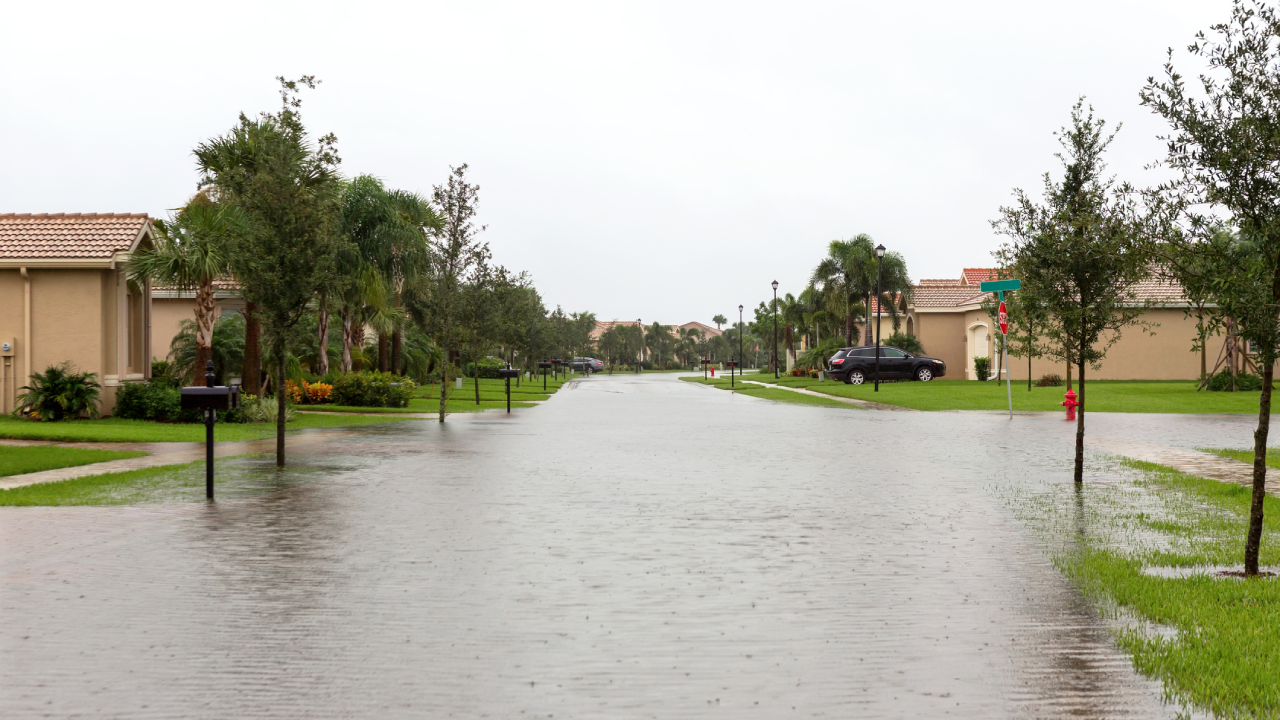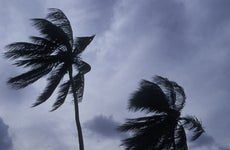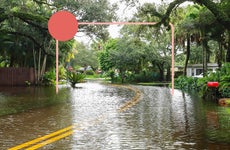Florida flooding focuses attention on uninsured Americans

The Bankrate promise
At Bankrate, we strive to help you make smarter financial decisions. To help readers understand how insurance affects their finances, we have licensed insurance professionals on staff who have spent a combined 47 years in the auto, home and life insurance industries. While we adhere to strict , this post may contain references to products from our partners. Here's an explanation of . Our content is backed by Coverage.com, LLC, a licensed entity (NPN: 19966249). For more information, please see our .
2023 marked a year of historic downpours for Florida, with record-breaking flash floods in Fort Lauderdale in April and double-digit deluges across South Florida in November. Coming just a year after the historic destruction of Hurricanes Ian and Nicole in 2022, Florida’s record-breaking rainfall forecasts a future of heightened flood risk—and an increased need for the financial protections of flood insurance.
Despite common misconceptions, standard home insurance policies don’t cover flood damage, and the overwhelmingly majority of U.S. homeowners don’t have personal flood insurance. With climate change ramping up the risk of flooding for Floridians, residents of the Sunshine State may be forced to confront that problem more urgently than other Americans. The good news: flood insurance is generally very affordable and can be purchased through multiple avenues.
- Out of all natural disasters, 90 percent include flooding, leaving almost all Americans at risk, regardless of location.
- Only 4 percent of Americans have a flood policy through the National Flood Insurance Program (NFIP) or a private flood insurer.
- Although uninsured homeowners and renters may qualify for disaster assistance, these programs aren’t enough (or intended) to replace flood coverage.
Understanding flood risk
There’s no question that the coastal flooding that resulted from Hurricane Ian’s storm surge was devastating — Fort Myers experienced a record storm surge of over seven feet high. However, the inland flooding that occurred in areas not widely considered flood-prone was particularly surprising. Orlando, for instance, experienced a 500-year flood event after Hurricane Ian’s relentless rain caused nearby rivers and lakes to spill over into streets, businesses and homes. And experts predict more to come; researchers at the Florida Climate Center warn of increased street flooding in both coastal and inland areas from sea level rise in the coming years.
If this inland Florida flooding highlights anything, it’s that those who don’t consider themselves at risk for flood may want to think again. Mark Friedlander, Director of Corporate Communications of the Insurance Information Institute (Triple-I), says,
We have seen catastrophic flood events impact all areas of the country over the past two years and most were not caused by hurricanes and tropical storms. As climate risk escalates, more regions are prone to flooding from severe storms all year round. Even California has experienced numerous flood events from atmospheric rivers over the past two winters.
Those that live far from the ocean may not think flood insurance is necessary, but inland flooding is increasingly common and unpredictable. Even landlocked Americans carry flood risk if heavy rain or melting snow overwhelms their municipality’s storm drain system or causes a nearby lake or river to overflow. Flood insurance, whether federally-backed coverage through the NFIP or purchased through a private carrier, may be the best defense against the catastrophic financial consequences a flood could bring to many homeowners and renters.
Americans are uninsured for floods
A 2023 poll conducted by Triple-I and Munich RE reports that 22 percent of homeowners state that they are at risk for flooding, and about 78 percent of those homeowners purchased flood insurance. However, about 14 percent of people stated they didn’t know if their home was at risk. Among homeowners with flood coverage, 35 percent indicated their coverage is through a private insurer, while most stated they secured flood coverage through the National Flood Insurance Program (NFIP).
Americans that are not aware of their home’s flood risk may assume they have flood coverage through their property insurance without realizing that standard homeowners insurance doesn’t cover floods, nor do renters policies. Friedlander also notes that many Florida homeowners “assume their windstorm coverage also includes the flood damage caused by tropical cyclones,” which is not the case. According to the Flood Coalition’s interpretation of First Street Foundation’s 2023 Flood Factor model, 14.6 million properties have a high risk of flooding. This is 68 percent more than estimated by the Federal Emergency Management Agency (FEMA), meaning millions of Americans may be unprotected against flood damage.
Compared to the rest of the U.S., the Sunshine State is an outlier regarding flood coverage — FEMA Press Secretary Jeremy Edwards says that Florida has the country’s highest concentration of NFIP policies, holding 35 percent of total policies written.
Even if Florida holds the most NFIP policies, the vast majority of its residents are still uninsured for floods; Triple-I found that only 18 percent of Floridians carry flood insurance, whether from the NFIP or a private carrier. The number of central Floridians with flood coverage is even lower, at a rate between 2 and 4 percent.
The combination of Florida’s extreme weather and relatively low flood insurance uptake rate comes with heavy consequences. Data analytics company CoreLogic found that Hurricane Ian may have caused $18 billion in uninsured flood damage. Although this study includes other impacted states like South Carolina, this data shows that lack of flood coverage is a massive problem, even in the state with the highest concentration of flood policies.
Do I need flood insurance?
Unless you are required to carry it by your mortgage company, flood insurance is optional for homeowners, but that doesn’t mean you don’t need it. It may be essential to check the FEMA flood zone map and Risk Factor to assess your risk tolerance. Remember, though, the majority of America faces flood risk. With an average cost of $888 per year, flood insurance may provide significant financial protection for what may be the largest investment you make during your life — your home.
To put it into perspective, the NFIP found that one inch of floodwater is capable of causing up to $25,000 in damage. In contrast, the average American may have around $5,300 saved in their bank accounts. That means the average American would have to come up with an additional $19,700 in a single-inch flood loss unless they had insurance. Although these amounts can vary, the chances of financial hardship are high for uninsured people during a flood event.
When deciding if you need flood insurance, you should know that flood insurance policies generally have a waiting period to take effect. Additionally, insurance companies commonly impose moratoriums, or pauses, on new coverage ahead of significant weather events. Waiting until it’s too late to purchase flood insurance could prove to be a costly mistake.
Disaster assistance and emergency relief programs
Uninsured homeowners and renters devastated by flooding may qualify for help through disaster assistance and emergency relief programs. While these programs do not replace proper flood coverage, they may provide financial support for those in need.
FEMA grants
Once the federal government officially declares a disaster, like a hurricane, wildfire or earthquake, FEMA steps in to help get uninsured Americans back on their feet.
Unless misused, FEMA grants do not have to be paid back and are meant for home repairs, temporary housing, food, clothing, transportation assistance and other essential needs. How much these grants are (or whether they are awarded at all) depends on the situation.
Edwards explains,
Disaster assistance is designed to jumpstart survivors’ recovery efforts…Not everyone will receive FEMA assistance or receive assistance that covers all their losses. But we’re doing more outreach and knocking on more doors to meet people where they are and communicate what assistance they may be eligible to receive.
All that is to say, FEMA assistance is granted on a case-by-case basis and is never guaranteed. Although this assistance is vital, it doesn’t replace flood insurance. In fact, FEMA states that its grants can make homes safe, sanitary and liveable, but that they’re not likely to be enough to make you whole.
Those that live in a federally-declared disaster area in need of assistance can visit FEMA’s Individual Assistance database for more information.
Small Business Administration (SBA) Disaster Loan
For some, FEMA disaster assistance may not be enough. This is where a Small Business Administration (SBA) disaster loan can help. Contrary to their name, SBA loans aren’t just for businesses — renters and homeowners can be eligible, too. Home and personal property SBA loans may provide:
- Up to $500,000 for homeowners to use for repairs or to replace their primary home
- Up to $100,000 for homeowners and renters to repair or replace personal property
Unlike FEMA disaster assistance, SBA loans need to be paid back. However, SBA loans are typically lower interest than those of traditional lenders and can help cover the gap eligible homeowners and renters may have after experiencing an uninsured flood.
Affected homeowners and renters interested in applying for an SBA disaster loan can do so online.
Nonprofit organizations
From food insecurity to clean up to search and rescue, these nonprofit organizations may help uninsured flood victims return to normalcy:
- Red Cross: After natural disasters, the Red Cross frequently provides food, water and clean up resources for those living in impacted communities.
- United Cajun Navy: Trained in search and rescue, the United Cajun Navy can help locate missing people after a flood.
- National Voluntary Organizations Active in Disasters: The National Voluntary Organizations Active in Disasters (VOAD) is a group of more than 130 organizations that help with a wide array of issues after a natural disaster.
- World Central Kitchen: Founded by celebrity chef José Andrés, the World Central Kitchen provides hot meals, sandwiches and water in communities devastated by natural disasters.
- Crisis Cleanup: Crisis Cleanup works by pairing victims with volunteer organizations that can help with debris removal after certain disasters.
- Operation Blue Roof: Led by the U.S. Army Corps of Engineers, Operation Blue Roof works with FEMA to install temporary roofs for homeowners impacted by hurricanes.
Flood insurance tips for Florida homeowners
Flood insurance in Florida is fairly affordable compared to other types of coverage, with 42 percent of policies in force as of 2022 costing under $1,000 per year, according to FEMA. Though expensive homes in particularly high-risk areas may raise the average cost of flood insurance in Florida, the overall average is $2,213 per year.
You can get flood insurance directly through FEMA or through a private insurer. It’s typically paid in full and purchased as lender-required coverage when you set up your mortgage. To get started, consider the following steps:
- Check if your community participates in the NFIP: To purchase flood insurance through the NFIP, you must live in a participating community. The NFIP maintains a current list of participating communities in Florida.
- Talk to your insurance agent: If you don’t live in a participating community, you’ll have to purchase flood insurance through a private insurer. Ask your agent about options.
- Take steps to lower your flood risk: Whether or not you’re eligible to purchase flood insurance, retrofitting your home with flood protection measures can help to reduce your flood risk.
- Ask about elevation certificates: While they’re no longer required in order to purchase flood insurance under FEMA’s Risk Rating 2.0 system, elevation certificates can lower the cost of flood coverage for homeowners. Check with your local floodplain manager to see if one’s already on file, and hire a professional to create one if not.
Bottom line
Although flood insurance is optional for most, this coverage can offer formidable financial protection against one of the most costly losses you can experience. Facing a flood without flood insurance means you may have to rely on disaster assistance and the kindness of volunteers to rebuild your life since even the best home insurance coverage excludes flood damage in most cases. While these programs are invaluable, you could still find yourself with a hefty amount of debt.
Perhaps most importantly, don’t wait until a storm is headed your way to consider flood insurance — by that time, it may be too late. You might think it a far-flung possibility, but the data shows: no matter where you live, you’re likely at risk for flooding.
Related Articles


Can lawmakers save the collapsing Florida home insurance market?

